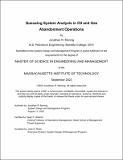Queueing System Analysis in Oil and Gas Abandonment Operations
Author(s)
Monnig, Jonathan R.
DownloadThesis PDF (2.611Mb)
Advisor
Willems, Sean P.
Terms of use
Metadata
Show full item recordAbstract
Oil and Gas (O&G) well abandonments are crucial in ensuring environmental and regulatory compliance in the industry. This thesis characterizes an O&G well abandonment system and process using well-plugging regulations from six major hydrocarbon-producing states in the United States. A comprehensive process flow diagram depicting the O&G well abandonment process is presented. The well abandonment process is further characterized as a queueing system and a queueing network model is developed.
The study introduces four job prioritization classes to explore the impact of prioritization and priority queues on the defined system performance metrics. Due to the complexity of the system, and instances when the server capacity required exceeds the capacity available, traditional queueing equations are inadequate, necessitating the use of simulation. The simulation, implemented using Python and the SimPy library, assesses the system's behavior and efficiency. The functionality of the simulation is demonstrated through five insights that explore varying architectures of the developed queueing system, encompassing server prioritization schemes, service channel configurations, job priority compositions, review periods, and dynamic server counts.
This analysis employs queueing theory to model the stochastic behavior of the O&G well abandonment process, emphasizing the need for simulation. The resultant model identifies dominant queueing system architectures, including combined service channel configurations, priority queues, and review periods that reduce average throughput times and variability of prioritized jobs in the well abandonment process.
Date issued
2023-09Department
System Design and Management Program.Publisher
Massachusetts Institute of Technology